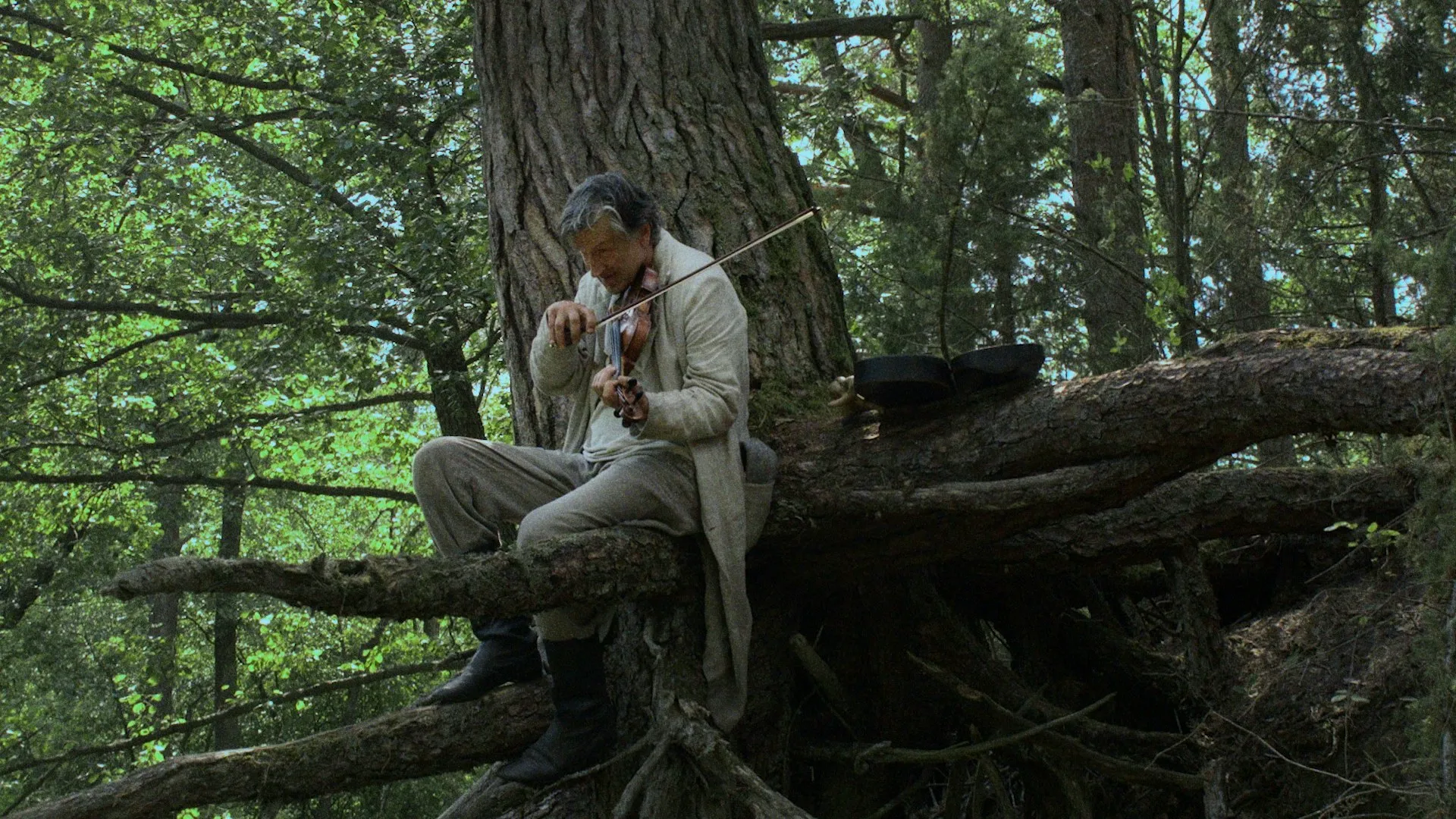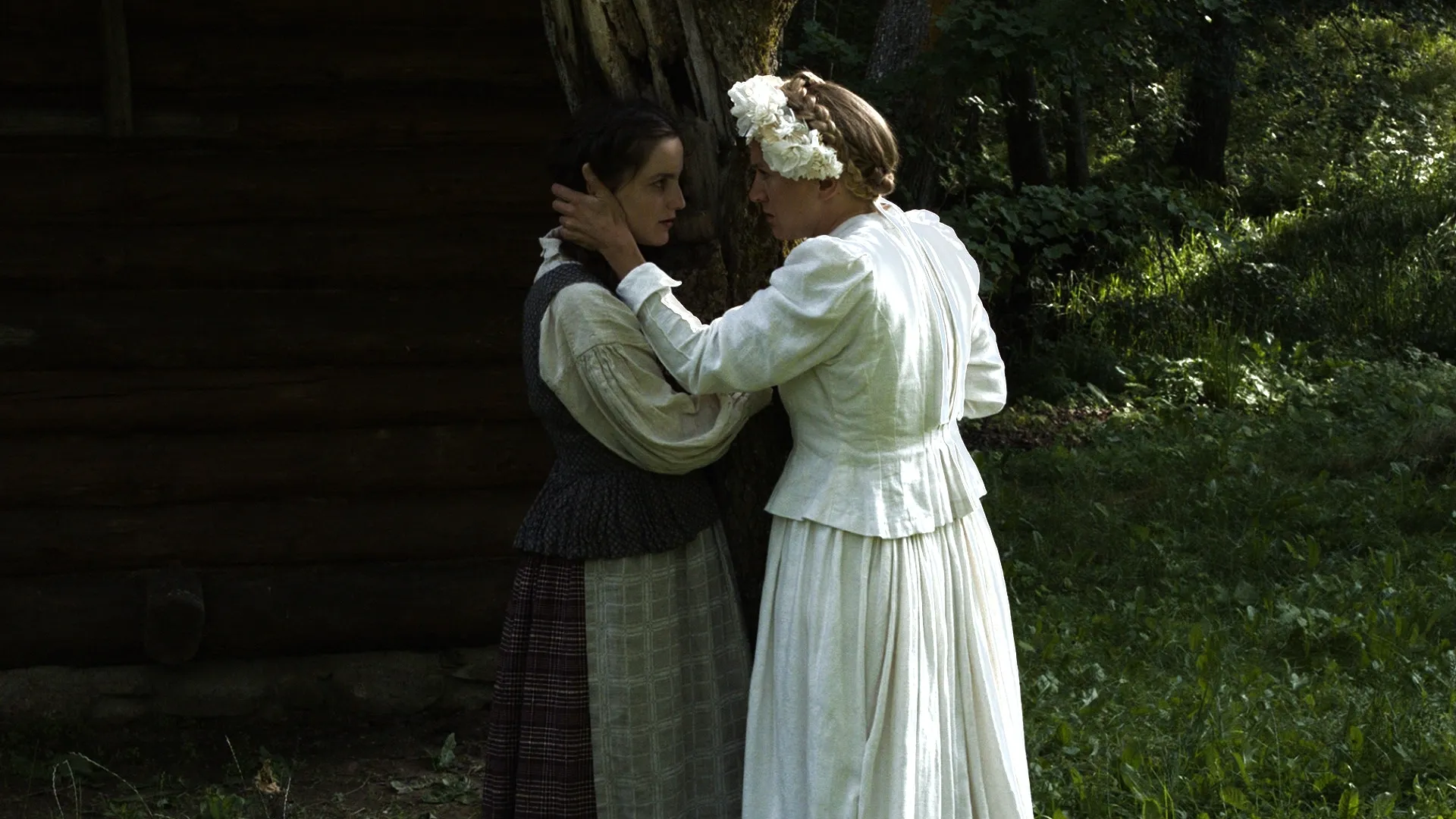Stereo 3D in Twittering Soul is a doorway, inviting watchers to cross the thin line between the real and the supernatural. The audience is immersed in a visceral experience where depth becomes a metaphor for existential inquiry thanks to this technique, which does not merely embellish the narrative.
One is forced to confront the haunting reality of isolation and interconnectedness as the layers of the Lithuanian landscape unfold before the eye. The 3D imagery in the film gives it a dreamlike quality, luring us into a world where the lines between memory and present are blurry and shadows from the past whisper secrets.
Each scene is expertly framed by cinematographer Ei TV das Dokus, who uses natural light to create moments between beauty and unease. Static shots that look like museum dioramas make you think, but they also give you a sense of voyeurism because the viewer is both a spectator and a participant in this ritualistic tableau.
The composition, which is frequently harsh and unyielding, reflects the weight of history on the individual soul, evoking an unsettling knowledge of mortality and the fleeting nature of existence. This visual language, full of philosophical themes, makes us ponder: what do we grasp in our search for meaning in a world where life is but a flicker?
The Ephemeral Threads of Existence
Twittering Soul is like a collection of broken dreams. Each short story is a quick look into a world full of superstitions and fears that haven’t been thought through.
The narrative is hazy and rambling, like the fiddlers’ paths through the dense Lithuanian forests, where time seems to dissolve into an atmosphere heavy with existential dread.
A talk about the afterlife, a snake bite, and a funeral where the deceased floats skyward are not just story points; they are symbols of the unavoidable passage of time and the haunting specter of death that hangs over life’s fleeting pleasures.
The film’s non-linear storytelling engages us with its episodic nature, pushing the viewer to piece together a tapestry of familiar and strange experiences. Folklore serves as a guide, weaving ancient myths into the fabric of the narrative, suggesting that the echoes of the past are not just echoes but live things that affect how we see reality.
When characters talk about ghosts and witches, it reminds us of the thin line between what we know and what we don’t know, between what is real and what is imagined. Like the characters, are we stuck in our stories, or can we break free from the bonds that bind us? This interplay between myth and reality asks profound questions. The film makes us ponder the weight of our histories, the shadows they cast, and the certainty of our mortality, leaving us uncertain.
Echoes of a Lost Era
The specter of change looms ominously over a society rooted in superstition and tradition in Twittering Soul, which is set against the backdrop of late 19th-century Lithuania. Between the whisper of the old world and the clamor of the new, this era, marked by the slow rise of modernity, is imbued with a palpable tension.
The film captures the essence of a society on the verge of change as the characters navigate dense woods and remote towns. The rich tapestries of folklore serve as a refuge and a reminder of what is to come.
The historical importance is not just a backdrop; it is woven into the narrative very complexly. An early capitalism specter suggests that social movement is changing and community ties are weakening. Myths and tales emerge in this environment as stories and lines of life, providing a sense of identity in the face of uncertainty.
The film’s look at Lithuanian folklore, where snakes move through the bushes and ghosts lurk in the shadows, reflects a culture struggling with its existence, as every story reflects mortality, fear, and the unknowable.
Oral tradition becomes an important link that holds communities together and protects the memory of a whole group of people. The weight of history is reflected in each folk tale told in the film, which prompts existential inquiries about the nature of belief and the stories we choose to tell. Twittering Soul challenges us to confront our narratives in this way, inviting us to reflect on what we carry from the past and how those echoes shape our present.
The Dichotomy of Existence
The peasant women in Twittering Soul are haunting representations of strength and change. Their lives are shaped by the cycles of nature and the weight of family story. These characters move through a world that oscillates between the mundane and the magical while being depicted with delicate yet profound complexity.
Their lives, characterized by beauty, pain, and the transient nature of existence, are a powerful reflection of the human situation. As one woman is stung by a snake, the moment captures a paradox: the danger of life and the promise of rebirth as they change into nymphs and swim through the bank of the river. This change doesn’t just mean escaping reality; it also means digging deeper into who you are, erasing the physical and spiritual lines.
On the other hand, the landowners live in a world marked by luxury and distance. Their existence, confined to the walls of their manor, reflects a limited view that only sees the land as a resource. Characters like Dvarininkas, who are deeply interested in photography and the material, show a profound disconnect from the life force that flows through the earth they work on. Who gets the essence of life—the one who cultivates it or the one who sells it—given the contrast between the landowners and the peasants?
The broader themes of power, loss, and the search for meaning in a changing world quickly become more apparent as the narrative progresses. The characters’ quiet conversations highlight the fragility of existence itself by creating a sense of shared humanity. Narkeviius uses this lens to create a narrative full of philosophical meaning, leaving us to ponder the importance of our parts in the tapestry of life.
The Shadows of Mortality and Change
Death appears in Twittering Soul not as an end but as a haunting presence that makes its way through the fabric of existence and casts a long shadow over the rural landscape. The film treats death as a rite of passage rather than the end of life, and it is imbued with a spectral beauty.
Rituals surrounding death, like the touching scene where the deceased is let float gently out of a window, have a lot of cultural meaning, suggesting a belief in the permeability of the line between life and the afterlife. The community’s respect for the deceased and their understanding of death as a continuum, an essential part of the life cycle, is made abundantly clear in these symbolic moments. In this case, death is used as a mirror to reflect the fragility of human experience, forcing the viewer to confront their mortality and the legacy they leave.
This look at death shows a clear tension between tradition and modernity. The film depicts a society on the verge of change, where traditional belief systems fight with the realities of capitalism and technological progress. The landowners living in their manor halls represent modernity’s goals; they see the world through the lens of progress and wealth. On the other hand, the peasant women stay connected to the earth and have rituals and folklore woven into their daily lives. This contrast brings up a deeper moral question: what do we lose as society changes for the better?
Narkeviius asks us to reflect on the social changes that could weaken the very foundations of cultural identity. The haunting melodies of folk songs, the whispers of ancient superstitions, and the rituals that connect the living with the dead remind us that the essence of humanity—the stories we tell and the traditions we uphold—may be the truest form of resistance against the void of modernity in the unrelenting march of time. The film’s profound sense of longing is reflected in this interplay of themes, and it begs the question of what it means to remember the past while navigating the unknown future.
A Liminal Space of Sound and Silence
A thick tapestry of sound and images surrounds the viewer in Twittering Soul, creating a haunting and meditative mood. A sound design that oscillates between the natural and the strange complements the film’s visual palette, which is soaked in the richness of Lithuania’s scenery.
Whispering winds, faraway chimes, and the rustling of leaves come together to create a symphony of nature, and folk tunes ring out with a longing rooted in the narrative’s cultural roots. This careful arrangement of sound improves the visual experience and deepens the film’s existential thoughts, inviting the audience to explore the silence beneath the surface.
The emotional impact is profound but elusive as viewers are drawn into this hypnotic world, similar to a dream that is only half-remembered. The film’s steady pace and short stories encourage introspection, which keeps viewers between reality and the fantastic. An undercurrent of fear in moments of beauty makes people feel anything from awe to discomfort. The viewer faces their reflections in this space, dealing with themes of loss, memory, and the unstoppable passage of time. This space serves as a reminder that the most profound truths are often hidden in the quiet places of life, waiting to be discovered.
The Review
Twittering Soul
Twittering Soul is a profound look at existence that skillfully weaves together themes of death, tradition, and the invasion of modernity against the backdrop of late 19th-century Lithuania. Its haunting images and evocative soundscape create a meditative atmosphere that hits you hard, forcing you to think about the fragility of life and the weight of history. The film's rich cultural tapestry and lyrical storytelling transport viewers to a world where folklore and reality coexist, leaving an indelible mark on the mind.
PROS
- Stunning visuals that capture the beauty of the Lithuanian landscape.
- Engages with profound existential themes of death and tradition.
- Immersive audio that enhances the film's atmosphere and emotional depth.
- Well-developed peasant and landowner characters that reflect societal tensions.
- Strong connection to Lithuanian folklore and rituals.
CONS
- The slow narrative may alienate viewers seeking a more conventional storyline.
- Some themes and symbols may feel elusive or open to interpretation, potentially frustrating some audiences.
- The film's darker, contemplative nature may not resonate with all viewers.




















































